Problem-solving Strategy
You should follow a series of steps whenever you are problem solving:
Step One
Determine the system of interest and identify what information is given and what quantity is to be calculated. For example, let's assume you have the problem with car on a roller coaster. You know that the cars of a roller coaster reach their maximum kinetic energy (

Determining Energy
The cars of a roller coaster reach their maximum kinetic energy when at the bottom of their path. When they start rising, the kinetic energy begins to be converted to gravitational potential energy. The sum of kinetic and potential energy in the system remains constant, ignoring losses to friction.
Step Two
Examine all the forces involved and determine whether you know or are given the potential energy from the work done by the forces. Then use step three or step four.
Step Three
If you know the potential energies (
Step Four
If you know the potential energy for only some of the forces, then the conservation of energy law in its most general form must be used:
where
Step Five
You have already identified the types of work and energy involved (in step two). Before solving for the unknown, eliminate terms wherever possible to simplify the algebra. For example, choose height
Step Six
Check the answer to see if it is reasonable. Once you have solved a problem, reexamine the forms of work and energy to see if you have set up the conservation of energy equation correctly. For example, work done against friction should be negative, potential energy at the bottom of a hill should be less than that at the top, and so on.